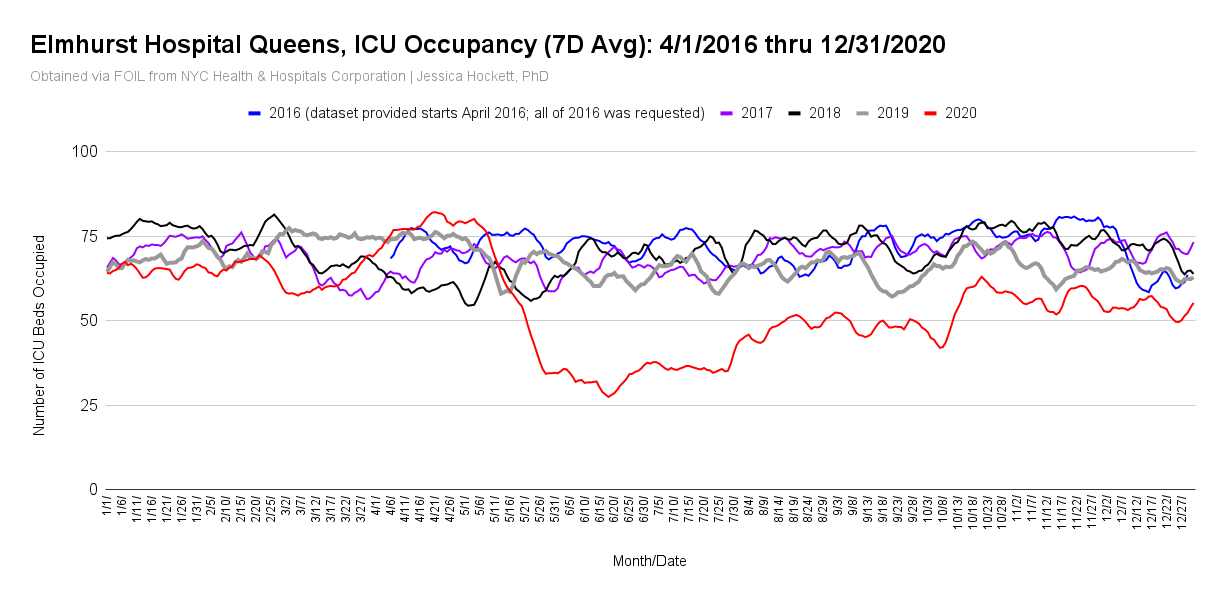
“April is the cruelest month, breeding Lilacs out of the dead land, mixing Memory and desire, stirring Dull roots with spring rain.” –T.S. Eliot, The Wasteland (Part I, The Burial of the Dead)
A recent retrospective piece by the NY Times titled, “Covid Was Bad in New York City. See How Bad on a 200-Year Timeline”, took a look back to Spring 2020 in New York City and the “wave of illness” that hit the city causing a “seismic” death event not seen in nearly 200 years.
Noting that the the spike in the city’s death rate was “like something from a different era” and that life expectancy dropped city-wide an astonishing 4.6 years from 2019 to 2020, the article unquestioningly and exclusively attributes this shocking mortality event to the impacts of Covid.
Nowhere in the piece, as is the case with the official narrative, can one find a more extensive examination of events as they unfolded in NYC in Spring 2020 though there are hints even within the article that oddities which defy the accepted narrative abound.
Towards the end of the article it is noted, “In Brownsville, Brooklyn — an impoverished and predominantly Black neighborhood with a high concentration of public housing developments — the premature death rate was nine times as high as in Greenwich Village and SoHo, predominantly white and wealthy Manhattan neighborhoods.”
While it could be justifiably argued that the poor are beset by an array of pre-existing health problems, thus impacted disproportionately by disease due to these lower health indices, would this not make the case that the inferior health of these communities is the issue, not some deadly disease?
This also brings up a range of questions as to how such a fast moving, super contagious and deadly virus selectively opted to hit poor, minority communities while percipiently avoiding upscale principally white neighborhoods.
Further in the article it is acknowledged that, “Many people went without seeing doctors or receiving medical care when Covid-19 arrived. Deaths from heart disease, for instance, were nearly 20 percent higher in 2020 than the year before.”
Even as this anomaly is recognized, logical follow-up questions posited are omitted, questions which could present a more complete picture of this cataclysmic event.
How many of these individuals who died due to avoidance of medical treatments would still be alive had they not been dissuaded from seeking medical care by the constant fear-based narrative?
How many of these deaths from heart disease were falsely attributed to Covid?
While certain incongruities can be discerned in this one article, this hardly scratches the surface.
The spectrum of unanswered questions is substantial.
A necessary full scale investigation into the events of Spring 2020 would undoubtedly unleash a multitude of inconvenient questions:
What was the location of the reported waves of death in NYC?
Were NYC emergency rooms truly overwhelmed?

What does the data say about NYC ICU rates?



Was Elmhurst hospital, tabbed as “coronavirus ground zero”, truly overflowing in Spring 2020?


What does the data say about Elmhurst hospital Spring 2020 emergency visits compared to previous years?

What was the 2020 emergency like for NY-Presbyterian Columbia hospital inpatient volume?

What does the data indicate for Maimonides Medical Center, understood to be the NYC hospital with the highest number of Covid deaths between March and May 2020?

What medical procedures and protocols were being used inside hospitals to treat Covid patients? To what effect?
What drugs were used in NYC hospitals?
What impact did newly introduced Covid-19 Do-Not-Resuscitate Orders have on patient outcomes?
How did financial incentives dictate hospital policies?
Who were the people that died during this time?
The colossal dimensions of the media reports coming out of New York City in Spring 2020 cannot be overstated as the alleged onslaught of Covid-related illnesses and ‘wave of deaths’ in NYC hospitals became the circuit breaker for the entire mass hysteria that subsequently beset the United States and the primary ‘code red’ rationale for national lockdowns and suspension of civil liberties across the country.
The mainstream news outlets reportage and blind acceptance of overwhelmed hospitals, dead bodies piled into trucks, lines of people anxiously waiting outside hospitals and various sci-fi scenarios struck terror into the hearts of those who witnessed these images as they sat glued to their television.
Three years on, an unquestioning media gives the impression that mass deaths caused by a novel pathogen is an unassailable truth.
However, the Spring 2020 apocalyptic scenario of a deadly pathogen besieging New York City increasingly looks to be a disputable chronicle of events rather than an ironclad narrative.
Who can forget Andrew Cuomo crying about an urgent need to get more ventilators?
Who can forget the scarcely used 70,000-ton ‘message of hope’ Navy hospital ship sent to NYC?
As further evidence and hospital data comes to light a picture emerges which stands in stark contrast with the story portrayed by the mainstream media.
The world deserves a full scale investigation into what happened throughout New York City in Spring 2020 and specifically what happened within the NYC hospitals.
This article is inspired by and links to Dr. Jessica Hockett’s independent research on New York City’s 2020 mortality event. Hockett holds a PhD in educational psychology from University of Virginia and shares the results of her personal inquiries on Twitter @Wood_House76 and Substack.














